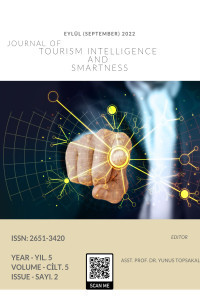Impact of Tourism Development (TD) on Non-Material Well-Being (NMWB) of Residents of Chittorgarh, Rajasthan
Impact of Tourism Development (TD) on Non-Material Well-Being (NMWB) of Residents of Chittorgarh, Rajasthan
This study is undertaken to understand the impact of perceived tourism development on non-material well-beings (NMWB) naming Community Well-Being, Health and Safety Well-Being, and Emotional Well-Being of residents of Chittorgarh district of Rajasthan (India). Present study has adopted the quantitative approach. Interpretation was done on the basis of sample of 200. Exploratory factor analysis was done to identify the factor and the suitability of the scale in the study area. To find the impact of perceived tourism development on non-material well-being Regression analysis was applied. Finding of the study reflects that, tourism has a significant positive impact on the non-material well-being (community well being, emotional well being and health and safety well being) of resident of Chittorgarh (Rajasthan).
Keywords:
Tourism Non material well being, Community,
___
- Alatartseva, E. & Barysheva, G. (2015). Well-being: Subjective and Objective Aspects. Procedia - Social and Behavioral Sciences, 166, 36-42.
- Andrews, F. M. & Withey, S. B. (1976). Social indicators of well-being: Americans’ perceptions of life quality. New York: Plenum Press.
- Angeloni, S. (2015). Cultural tourism and well-being of the local population in Italy. Theoretical and Empirical Researches in Urban Management, 8(3), 17-31.
- Aref, F. (2011). The effects of tourism on quality of life: A case study of Shiraz, Iran. Life Science Journal, 8(2), 26-30.
- Churchill, G.A. & Iacobucci, D. (2005), Marketing Research: methodological Foundation, 9th Ed. New York: Thomson South-Western Publisher.
- Cummins, R. A. (1996). Assessing quality of life. In R. I. Brown (Ed.), Quality of life for handicapped people (pp. 116–150). London, England: Chapman and Hall.
- Haq, R. & Zia, U. (2008). Dimensions of well-being and the millennium development goals. Pakistan Development Review, 47(4), 851–876.
- Jcu, R. (2016). Tourism and community well-being: social impacts of tourism in Australian tropical communities. PhD thesis, James Cook University.
- Jurowski, C., Uysal, M. & Williams, D. R. (1997). A theoretical analysis of host community resident reactions to tourism. Journal of Travel Research, 36(2), 3–11.
- Kim, K. (2002). The effects of tourism impacts upon quality of life residents in the community. Virginia Polytechnic Institute and State University, Blacksburg
- Lundberg, E. (2014). Tourism {Impacts} and {Sustainable} {Development}. Retrieved from https://gupea.ub.gu.se/handle/2077/35744
- Manav Thadani & Shunit C. Roy (2017) India State Ranking Survey.
- McGehee, N. G. & Andereck, K. L. (2004). Factors predicting rural residents’ support of tourism. Journal of Travel Research, 43(2), 131–140.
- Meier, G. (1991) Pareto, Edgeworth and Hicks: The Education of an Economist. Review of Political Economy, 3(3), 349-353.
- Moore, C. A. & Keyes, C. L. M. (2003). A brief history of the study of well-being in children and adults. In M. H. Bornstein, L. Davidson, C. L. M. Keyes & K. A. Moore (Eds.), Well Being: Positive Development across the Life Course (pp. 1-11). New Jersey: Lawrence Erlbaum Associates.
- Prescott-Allen, R. (2003). The Well-being of Nations: A Country-by-Country Index of Quality of Life and the Environment. Washington, DC: Island Press.
- Przeclawski, K. (1986). Humanistic foundation of tourism. Warsaw: Poland: Institute of Tourism.
- Pyke, S., Hartwell, H., Blake, A. & Hemingway, A. (2016). Exploring well-being as a tourism product resource. Tourism Management, 55, 94–105.
- Rajasthan Progress Report, 2017-2018.
- Rajasthan Tourism Unit Policy 2015.
- Reynaldo, J.A. & Santos, A. (1999) Cronbach’s Alpha: A Tool for Assessing the Reliability of Scales. Journal of Extension, 37, 1-4.
- Schimmack, U., Schupp, J. & Wagner, G. G. (2008). The Influence of Environment. Social Indicators Research, 89, 41–60.
- Techatassanasoontorn, A. A. & Tanvisuth, A. (2008). The bottom-up and horizontal spillovers of life from continued ict use: The case of community technology centers. Association for Information Systems, (2008). Retrieved from http://sprouts.aisnet.org/8-18
- Williams, P. & Soutar, G. N. (2009). Value, satisfaction and behavioral intentions in an adventure tourism context. Annals of Tourism Research, 36(3), 413–438.
- Woo, E., Kim, H. & Uysal, M. (2015). Life satisfaction and support for tourism development. Annals of Tourism Research, 50(January), 84-97.
- World Tourism Organization. (2009). Indicators of sustainable development for tourism destination: A guidebook. Retrieved from http://www.unwto.org/pub/doc/UNWTO_pu b_cat_08_en.pdf January 1, 2018.
- Başlangıç: 2018
- Yayıncı: Yunus TOPSAKAL
